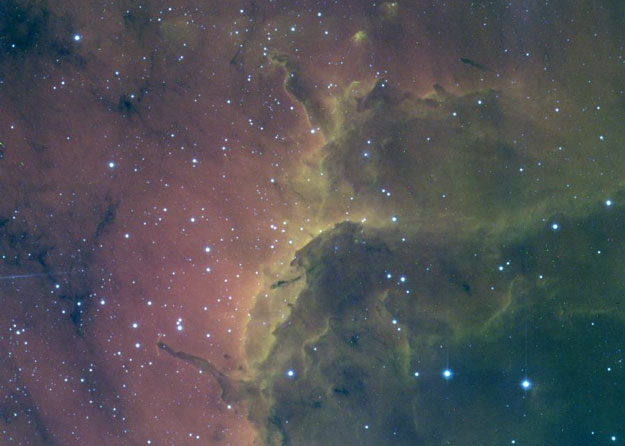
|
Explanation: The Pelican Nebula is slowly being transformed. IC 5070, the official designation, is divided from the larger North America Nebula by a molecular cloud filled with dark dust. The Pelican, however, receives much study because it is a particularly active mix of star formation and evolving gas clouds. The above picture was produced in two specific colors to better understand these interactions. Here, hot hydrogen gas glows in red, while cooler Sulfur glows blue-green. The light from young energetic stars is slowly transforming the cold gas to hot gas, with the advancing boundary between the two known as an ionization front. Particularly dense filaments of cold gas are seen to still remain. Millions of years from now this nebula might no longer be known as the Pelican, as the balance and placement of stars and gas will leave something that appears completely different.
|
January February March April May June July August September October November December |
| |||||||||||||||||||||||||||||||||||||||||||||||||||||||
NASA Web Site Statements, Warnings, and Disclaimers
NASA Official: Jay Norris. Specific rights apply.
A service of: LHEA at NASA / GSFC
& Michigan Tech. U.
Based on Astronomy Picture
Of the Day
Publications with keywords: nebula - ionization - Pelican Nebula - ionization front - Pelican
Publications with words: nebula - ionization - Pelican Nebula - ionization front - Pelican
See also:
- APOD: 2025 March 18 Á LDN 1235: The Shark Nebula
- APOD: 2024 June 11 Á Colorful Stars and Clouds near Rho Ophiuchi
- APOD: 2024 January 23 Á Deep Nebulas: From Seagull to California
- APOD: 2023 August 7 Á The Pelican Nebula in Gas, Dust, and Stars
- APOD: 2023 June 14 Á The Shark Nebula
- NGC 7380: The Wizard Nebula
- A Galaxy Beyond Stars, Gas, Dust
